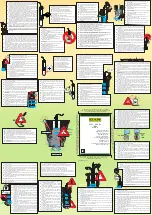
6
SECTION B: GENERAL INFORMATION
B-1) To the Purchaser:
Congratulations! You are the owner of one of the finest pumps
on the market today. CP&S pumps are products engineered
and manufactured of high quality components. Over one
hundred years of pump building experience along with a
continuing quality assurance program combine to produce a
pump which will stand up to the toughest applications. This
manual will provide helpful information concerning installation,
maintenance, and proper service guidelines.
B-2) Receiving:
Upon receiving the pump, it should be inspected for damage
or shortages. If damage has occurred, file a claim immediately
with the company that delivered the pump. If the manual
is removed from the packaging, do not lose or misplace.
B-3) Storage:
Short Term-
CP&S Pumps are manufactured for efficient
performance following short inoperative periods in storage.
For best results, pumps can be retained in storage, as factory
assembled, in a dry atmosphere with constant temperatures
for up to six (6) months. Long Term- Any length of time
exceeding six (6) months, but not more than twenty-four (24)
months. The unit should be stored in a temperature controlled
area, a roofed over walled enclosure that provides protection
from the elements (rain, snow, wind-blown dust, etc.), and
whose temperature can be maintained b40 deg. F
and +120 deg. F. (4.4 - 49°C). Pump should be stored in its
original shipping container. On initial start up, rotate impeller
by hand to assure seal and impeller rotate freely. If it is
required that the pump be installed and tested before the long
term storage begins, such installation will be allowed provided:
1.) The pump is not installed under water for more than
one (1) month.
2.) Immediately upon satisfactory completion of the test,
the pump is removed, thoroughly dried, repacked in the
original shipping container, and placed in a temperature
controlled storage area.
B-4) Service Centers:
For the location of the nearest Barnes Service Center, check
your Barnes representative or Crane Pumps & Systems, Inc.,
Service Department in Piqua, Ohio, telephone (937) 778-8947
or Crane Pumps & Systems Canada, in Brampton, Ontario,
(905) 457-6223.
SECTION C: INSTALLATION
C-1) Location:
These pumping units are self-contained and are especially
designed to handle septic tank effluent, nonexplosive or
noncorrosive liquids and shall NOT be installed in locations
classified as hazardous in accordance with the National
Electrical Code (NEC), ANSI/NFPA 70 or Canadian Electrical
Code (CEC). They will provide sufficient pressure to pump
material through small diameter, pipe to gravity interceptors,
treatment plants or remote leach fields. Never install the
pump in a trench, ditch or hole with gravel, stones, or earth
bottom; the legs will sink into the dirt and the suction will
become plugged, or the pump impeller will be damaged.
C-1.1) Submergence:
It is recommended that the pump be operated in the
submerged condition and the sump liquid level should never
be lower than the top of the pump. (see Fig 2)
C-2) Discharge:
Discharge piping should be as short as possible. Both a
check valve and a shut-off valve are recommended for
each pump being used. The check valve is used to prevent
backflow into the sump. Excessive backflow can cause
flooding and/or damage to the pump. The shut-off valve
is used to stop system flow during pump or check valve
servicing.
Barnes Effluent Pumps can be installed by one of two
methods: (1) the flex hose system, most commonly used
in interceptor tanks and (2) the stainless rail package and
stainless rail for concrete wet wells, designed to allow the
pump to be installed or removed without requiring personnel
to enter the wet well.
C-3) Liquid Level Controls:
The level controls are to be supported by a mounting bracket
that is attached to the sump wall, cover or junction box. Cord
grips are used to hold the cords in place on the mounting
bracket. The control level can be changed by loosening
the grip and adjusting the cord length as per the plans and
specifications. Be certain that the level controls cannot
hang up or foul in it’s swing and that the pump is completely
submerged when the level control is in the “Off” mode.
FIGURE 1
Summary of Contents for Barnes DS Series
Page 15: ...15 FIGURE 15 CONTIUED ...
Page 17: ...17 FIGURE 16 EH L Series Single Seal ...
Page 18: ...18 FIGURE 17 EH L Series Single Seal Used with Cast Iron Impeller 33 ...
Page 19: ...19 FIGURE 18 EH DS Series Double Seal ...
Page 20: ...20 FIGURE 19 EH DS Series Double Seal 66 USED WITH CAST IRON IMPELLER 33 ...
Page 23: ...23 Notes ...
Page 24: ...24 Notes ...







































